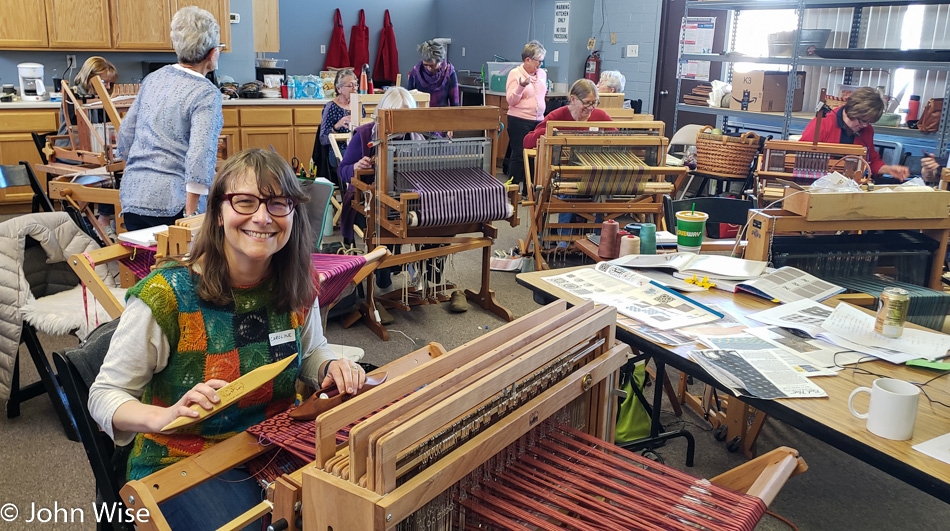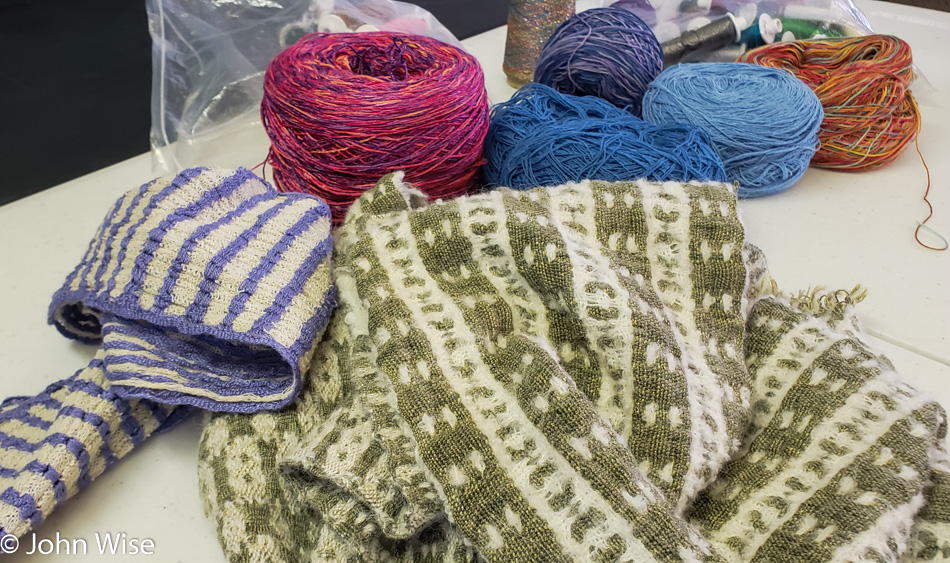
If there is any question that the Brillenschlange smiling at me in this photo is an uber-nerd, let this serve as proof that my wife has geek cred that flies off most every chart. You might remember that back on September 9, 2019, Caroline took possession of her Baby Wolf loom. Since then she’s been off and on again busy making stuff on it but this is the first time she’s been able to lunk it out of our place and drag it across town to Mesa, Arizona, so she could join a 3-day workshop.
All last week Caroline toiled after work to wind the warp which is the process of winding off the requisite number of weaving threads in the length that the project calls for. Next, you sley the reed. This means that she pulls all of the threads of the warp through a toothed device that keeps everything separate and aligned. Time to thread the heddles where she pulls each strand of yarn through a wire with an eyelet attached to a shaft controlled by treadles that are used to open a shed. Sheds are the opening of patterns of warp combinations where the weft (the thread that goes across the warp) is beat against the accumulating other wefts thus making cloth. Before that can begin though she has to beam the warp meaning she has to roll the warp on a beam in the rear of the loom that will feed to the front of the loom where she’s tied those warp thread ends to the cloth beam, allowing weaving to commence.

At the workshop, the Mesa guild known as Telarana Fiber Arts Guild has invited Denise Kovnat from Rochester, New York, to share a technique called “Deflected Double Weave” with the group. Workshop teachers are often from out of state and are likely renowned in the Weaving World which helps guarantee the success of the workshop as they need at least 10 attendees to make the event financially viable. (As a non-profit organization the guild just needs to break even when it is all said and done.)
Attendees such as Caroline are given a list of requirements they need to prepare prior to the workshop and then upon arrival, there may be handouts or options to purchase additional materials that could further enhance their knowledge or SABLE. This popular acronym stands for Stash Acquisition Beyond Life Expectancy and most every member of the guild is guilty of this hoarding disorder.

Through it all, these highly skilled and very sociable women gain between 18 and 24 hours of hands-on experience, collaboration, and gossip over the typical 3-day workshop.
The image above shows an example of Caroline’s effort where the colors and pattern decisions were part of her pre-work before arriving on Saturday. What you are looking at is the front of her loom in closeup. In the background is the reed and behind that, out of sight, are the heddles, shafts, and warping beam. The warp are the threads going from the pattern upfront to the reed in the background. Sitting on the cloth is the shuttle that is used to throw a thread through the sheds to be opened to lay down the emerging pattern.
Now consider for a moment that not all too long ago every strand of thread had to be handspun and dyed before they’d find their way to a loom and the more fine threads packed in per inch would typically mean a finer fabric. Should you ever wonder why certain cultures never developed cloth or why people right up to the industrial age had only one set of clothes, it was due to the intensive amount of labor involved with simply making sheets of cloth before they’d ever be cut up to be sewn into shirts and pants.